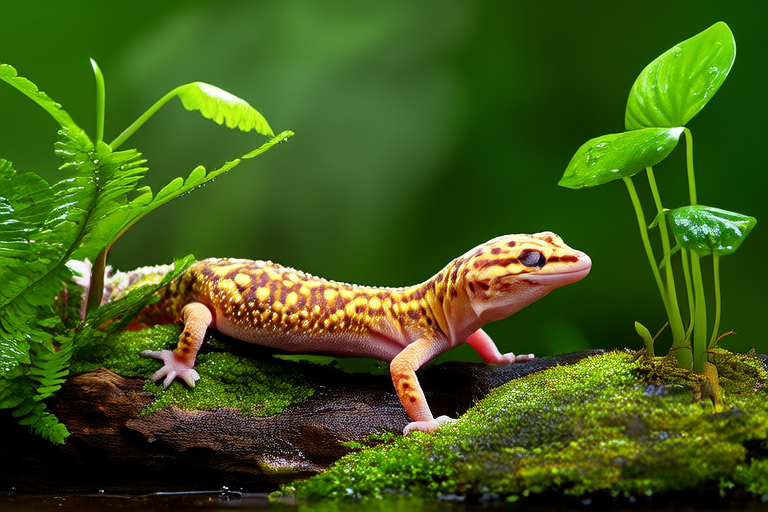Guide to Choosing the Right Plants for a Happy, Healthy Chameleon
Welcome to your comprehensive guide to selecting the perfect plants for your chameleon’s habitat. Understanding the importance of plants in your chameleon’s environment is crucial for ensuring its health and happiness. Let’s start by exploring the natural habitat of chameleons and how they interact with plants.
The Natural Habitat of Chameleons
Chameleons are arboreal reptiles, meaning they spend most of their lives among trees and vegetation. In their natural habitats, these creatures thrive in lush, green environments where they can find shelter, food, and companionship. The dense foliage provides them with the necessary camouflage, enabling them to blend into their surroundings and escape predators. Moreover, it offers them an ideal place to bask in the sun and absorb essential nutrients from the leaves.
The Importance of Plant Selection
Selecting the right plants for your chameleon’s enclosure is more than just about aesthetics; it’s about creating a healthy, stimulating environment that supports your pet’s physical and mental well-being. Here are some key reasons why choosing the right plants matters:
- Safety: Some plants may be toxic to chameleons, so it’s important to choose safe, non-toxic options.
- Nutritional Benefits: Certain plants can provide additional vitamins and minerals, enhancing your chameleon’s diet.
- Environmental Enrichment: A variety of plants can offer hiding spots, climbing areas, and basking locations, encouraging exercise and exploration.
Recommended Plants
Below is a list of plants that are both safe and beneficial for your chameleon:
Ficus Elastica (Rubber Plant)
Benefits: This large, evergreen plant is known for its thick, glossy leaves that provide ample shade and climbing opportunities. It also helps maintain humidity levels in the enclosure.
Care Instructions: Place the rubber plant in indirect sunlight and water it sparingly, allowing the soil to dry out between waterings.
Philodendron Bipinnatifidum (Split Leaf Philodendron)
Benefits: With its large, heart-shaped leaves, this plant adds a tropical touch to any enclosure while offering plenty of surface area for your chameleon to climb.
Care Instructions: Keep the split leaf philodendron in medium to bright indirect light and water it when the top inch of soil feels dry.
Pilea Peperomioides (Chinese Money Plant)
Benefits: This compact, round-leaved plant is easy to care for and adds a unique aesthetic appeal to your chameleon’s home.
Care Instructions: Position the Chinese money plant in a spot with bright, indirect light and water it when the soil feels dry to the touch.
Sansevieria Trifasciata (Snake Plant)
Benefits: Snake plants are excellent air purifiers and can help maintain proper humidity levels in the enclosure. Their upright, sword-like leaves also offer good climbing surfaces.
Care Instructions: These plants prefer bright, indirect light and should be watered sparingly, allowing the soil to dry out completely between waterings.
Toxic Plants to Avoid
Some common household plants can be harmful or even deadly to chameleons if ingested. Here are a few examples of toxic plants you should avoid:
- Dieffenbachia: Also known as dumb cane, this plant contains calcium oxalate crystals that can cause severe irritation if chewed.
- Euphorbia: The sap of euphorbias can irritate the skin and eyes, making them unsuitable for a chameleon’s enclosure.
- Lilies: All parts of lily plants are highly toxic to chameleons and other pets.
Maintaining a Thriving Plant Environment
Creating a balanced and functional plant environment within your chameleon’s enclosure requires careful planning and maintenance. Here are some tips to ensure your plants stay healthy and contribute positively to your pet’s habitat:
- Regular Pruning: Keep your plants trimmed to prevent overcrowding and promote new growth.
- Watering Schedule: Establish a consistent watering routine based on the specific needs of each plant.
- Lighting: Ensure your plants receive adequate light without overheating the enclosure. Use artificial lighting if necessary.
- Aesthetic Balance: While functionality is important, don’t forget to create an aesthetically pleasing environment that reflects your personal style.
In conclusion, choosing the right plants for your chameleon’s habitat is essential for its overall health and happiness. By understanding the importance of plant selection and providing a safe, nutritious, and enriching environment, you can ensure your chameleon thrives in its home. Remember, a well-planned enclosure not only benefits your pet but also enhances the beauty of your living space.
